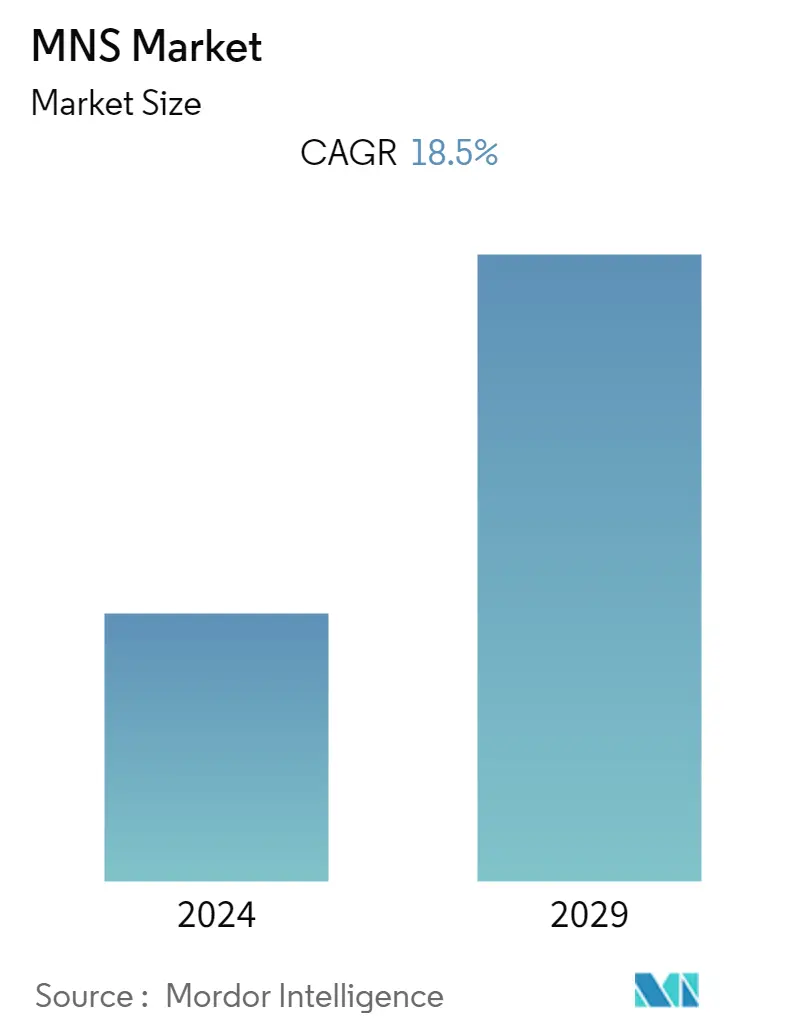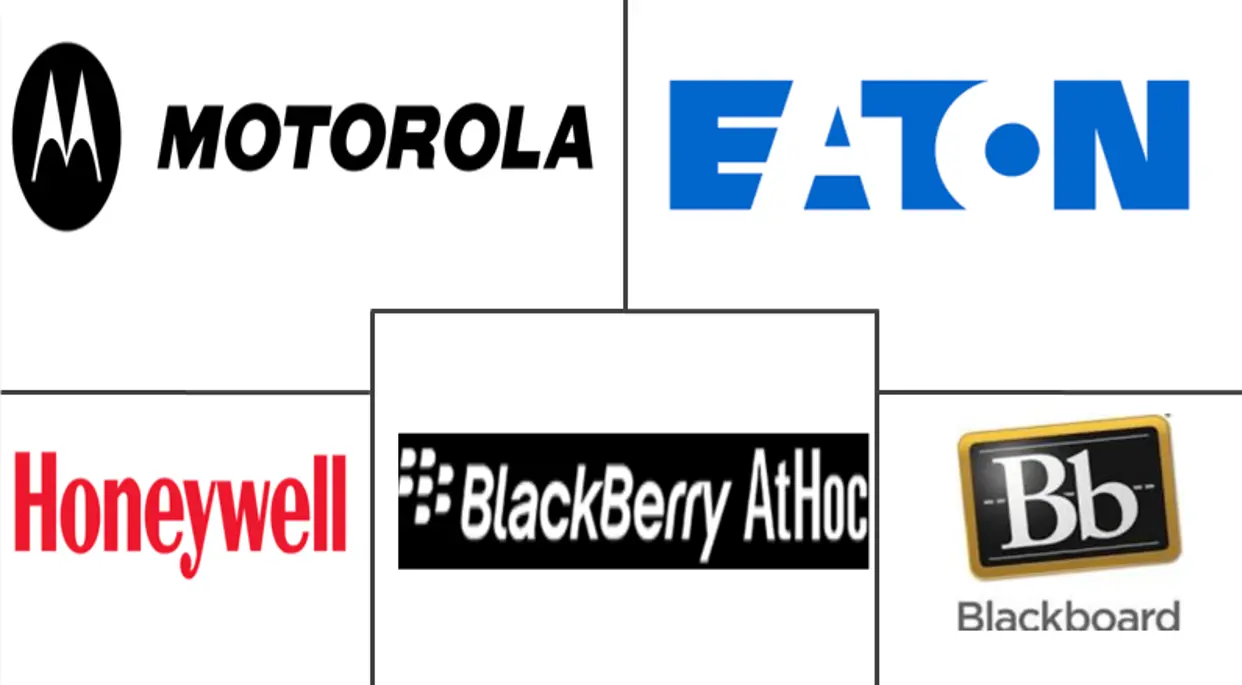Market Size of MNS Industry

| Study Period | 2021 - 2029 |
| Base Year For Estimation | 2023 |
| CAGR | 18.50 % |
| Fastest Growing Market | Asia Pacific |
| Largest Market | North America |
| Market Concentration | Medium |
Major Players
*Disclaimer: Major Players sorted in no particular order |
Mass Notification Systems Market Analysis
The Mass Notification Systems market is expected to register a CAGR of 18.5% during the forecast period. High Adoption of a Mass Notification System (MNS) across hospitals and medical facilities and increasing implementation of IP-based notification devices are expected to drive the market growth. However, inadequate rules and regulations across verticals could hinder the market growth.
- Public security is one of the primary concerns for both developed & developing countries, and it results in an upsurge in the adoption of MNS. MNS are critical systems during natural disasters, including hurricanes, floods, earthquakes, and circumstances threatening human life. It is an effective and direct way to communicate with the public, ensuring residents are up-to-date and have accurate information. It can be used for emergency and non-emergency situations and offers extensive threat response, staff protection, and regulatory compliance.
- With the COVID-19 outbreak across regions, more people are working from home, and governments worldwide are taking initiatives to slow the spread of the virus. Amid these changes, the need for a mass notification system is more than ever since the public health and safety department wants to share information with the public and guide them toward the right resources and dos & don'ts. Taking advantage of this scenario, a few players in the United States started offering their solutions for free/no cost to attract attention toward their solutions and platforms.
- Governments and first responders must warn and inform everyone at risk when critical events happen. Public warning systems effectively provide citizens and visitors from other countries with trusted information to help them stay safe. By June this year, the European Electronic Communications Code (EECC) Article 110 requires all EU countries to operate a public warning system that can send geo-targeted emergency alerts to all mobile phone users in the affected area during a natural or artificial disaster. In 2020, BEREC (the Body of European Regulators for Electronic Communications) also published its guidelines on assessing the effectiveness of public warning systems transmitted by different means to help governments implement Article 110.
- Public security concerns have risen over the last decade as individuals are defied with various hazardous situations from artificial and regular emergencies. The loss of life and damage to property can be enormous in the case of any destructive event. Each country has a different set of rules and regulations for managing Hazardous Materials (HAZMAT) incidents and industrial accidents and a separate and dedicated infrastructure to maintain public safety and security, which anticipates supporting the growth of mass notification systems.
- The market studied is witnessing an increase in competition among the players. Companies in the market are increasingly looking for strategic relationships to develop their existing systems. For instance, KOVA Corp. partnered with Everbridge, a prominent mass notification systems provider, to integrate its proprietary Emergency Alert Notification System (KEANS) with the groundbreaking group notification system pioneered by Everbridge. KEANS is a VoIP-based crash phone system that, coupled with Everbridge tech, will allow emergency management agencies and other organizations to send out notifications efficiently using various communications channels.
Mass Notification Systems Industry Segmentation
Mass Notification Systems are software solutions deployed to send out mass alerts as part of an emergency communication plan via text message, email, phone, or broadcast via speakers/sirens or television. These solutions are used by different end-user verticals, including Healthcare, Government, Educational sector (K-12), Enterprises, Energy and Utilities, etc., for business continuity, disaster management, emergency response, and communications, etc. Sometimes, the solutions enable notifications automatically triggered by warning events, such as extreme weather. Vendors also offer solutions that allow users to send information with one click, with a pre-configured message to a network of citizens, members, or subscribers.
The Mass Notification Systems Market is segmented by Component (Solution, Service), Deployment (On-premise, Cloud), Application (In-building, Wide Area, Distributed Recipient), Purpose of Deployment (Business Continuity and Disaster Recovery, Integrated Public Alert and Warning, Interoperable Emergency Communication), End-User Vertical (Energy and Utilities, Healthcare, Commercial, Government, Education), and Geography (North America, Europe, Asia Pacific, Latin America, and Middle East and Africa).
The market sizes and forecasts are provided in terms of value (USD million) for all the above segments.
| By Component | |
| Solution | |
| Services |
| By Deployment | |
| Cloud | |
| On-premise |
| By Application | |
| In-Building | |
| Wide-Area | |
| Distributed Recipient |
| By Purpose of Deployment | |
| Business Continuity and Disaster Recovery | |
| Integrated Public Alert and Warning | |
| Interoperable Emergency Communication |
| By End-User Vertical | |
| Energy and Utilities | |
| Healthcare | |
| Commercial | |
| Government | |
| Education | |
| Other End User Verticals |
| By Geography | |
| North America | |
| Europe | |
| Asia Pacific | |
| Latin America | |
| Middle East and Africa |
MNS Market Size Summary
The Mass Notification Systems (MNS) market is poised for significant growth, driven by the increasing need for public safety and effective communication during emergencies. The adoption of MNS is particularly high in sectors such as healthcare, where it serves dual purposes of routine communication and emergency alerts. The integration of Internet Protocol (IP) based notification devices is a key factor propelling market expansion, as these systems offer enhanced connectivity and efficiency. The demand for rapid message delivery in crisis situations, coupled with advancements in technology, is further fueling the market's growth. However, the market faces challenges due to inconsistent regulations across different sectors, which could potentially impede its progress.
The market landscape is characterized by intense competition, with a few dominant players holding a significant share. Companies are increasingly forming strategic partnerships to enhance their offerings and maintain a competitive edge. The COVID-19 pandemic has underscored the importance of MNS, as governments and health authorities have relied on these systems to disseminate critical information. Regulatory frameworks, such as the European Electronic Communications Code, are also shaping the market by mandating the implementation of geo-targeted emergency alerts. As public security concerns continue to rise, the MNS market is expected to witness sustained growth, supported by the presence of major industry players and ongoing technological innovations.
MNS Market Size - Table of Contents
-
1. MARKET DYNAMICS
-
1.1 Market Overview
-
1.2 Industry Attractiveness - Porter's Five Forces Analysis
-
1.2.1 Bargaining Power of Suppliers
-
1.2.2 Bargaining Power of Buyers
-
1.2.3 Threat of New Entrants
-
1.2.4 Threat of Substitute Products
-
1.2.5 Intensity of Competitive Rivalry
-
-
1.3 Market Drivers
-
1.3.1 Growing Adoption of Internet Protocol Based Notification Devices
-
1.3.2 Increasing Concerns About Public Safety
-
1.3.3 Increasing Adoption of MNS in Healthcare Sector
-
-
1.4 Market Challenges
-
1.4.1 Stringent Privacy Regulations Pertaining to Access to Individual Data
-
-
1.5 Assessment of the Impact of COVID-19 on the Market
-
-
2. MARKET SEGMENTATION
-
2.1 By Component
-
2.1.1 Solution
-
2.1.2 Services
-
-
2.2 By Deployment
-
2.2.1 Cloud
-
2.2.2 On-premise
-
-
2.3 By Application
-
2.3.1 In-Building
-
2.3.2 Wide-Area
-
2.3.3 Distributed Recipient
-
-
2.4 By Purpose of Deployment
-
2.4.1 Business Continuity and Disaster Recovery
-
2.4.2 Integrated Public Alert and Warning
-
2.4.3 Interoperable Emergency Communication
-
-
2.5 By End-User Vertical
-
2.5.1 Energy and Utilities
-
2.5.2 Healthcare
-
2.5.3 Commercial
-
2.5.4 Government
-
2.5.5 Education
-
2.5.6 Other End User Verticals
-
-
2.6 By Geography
-
2.6.1 North America
-
2.6.2 Europe
-
2.6.3 Asia Pacific
-
2.6.4 Latin America
-
2.6.5 Middle East and Africa
-
-
MNS Market Size FAQs
What is the current MNS Market size?
The MNS Market is projected to register a CAGR of 18.5% during the forecast period (2024-2029)
Who are the key players in MNS Market?
Honeywell International Inc., Eaton Corporation, Motorola Solutions Inc., BlackBerry AtHoc Inc. and Blackboard Inc. are the major companies operating in the MNS Market.

